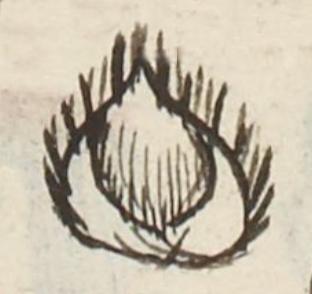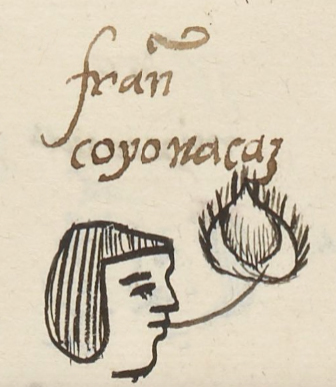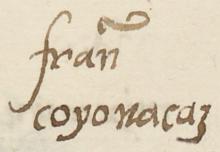Coyonacaz (MH496r)
This black-line drawing of the simplex glyph for the personal name Coyonacaz ("Coyote Ear," attested here as a man's name) shows a frontal-view of a coyote (coyotl) ear (nacaztli). It is as though the viewer is looking inside the ear. The ear comes to a point at the top. Hair is located inside and along the top edge.
Stephanie Wood
The hunting ability of the coyote was impressive to the Aztecs. At least some Nahuas saw a divine force in the Coyotlinahuatl, who could assume a human form. Rituals celebrating this force included regalia with "tails, sharp snouts, and erect ears." [See: Dan Flores, Coyote America (2016, 10).] Perhaps the hearing of coyotes was something especially appreciated.
Other notable features of coyotes include a recognition of a special aging coyote (Huehuecoyotl), and the famous Tetzcocan Nezahualcoyotl had the coyote attribute.
Stephanie Wood
franco
coyonacaz
Francisco Coyonacaz
Stephanie Wood
1560
Jeff Haskett-Wood
coyotes, ears, orejas, nombres de hombres

coyo(tl), coyote, https://nahuatl.wired-humanities.org/content/coyotl
nacaz(tli), ear, https://nahuatl.wired-humanities.org/content/nacaztli
Coyote-Oreja
Stephanie Wood
Matrícula de Huexotzinco, folio 496r, World Digital Library, https://www.loc.gov/resource/gdcwdl.wdl_15282/?sp=71&st=image
This manuscript is hosted by the Library of Congress and the World Digital Library; used here with the Creative Commons, “Attribution-NonCommercial-ShareAlike 3.0 License” (CC-BY-NC-SAq 3.0).




